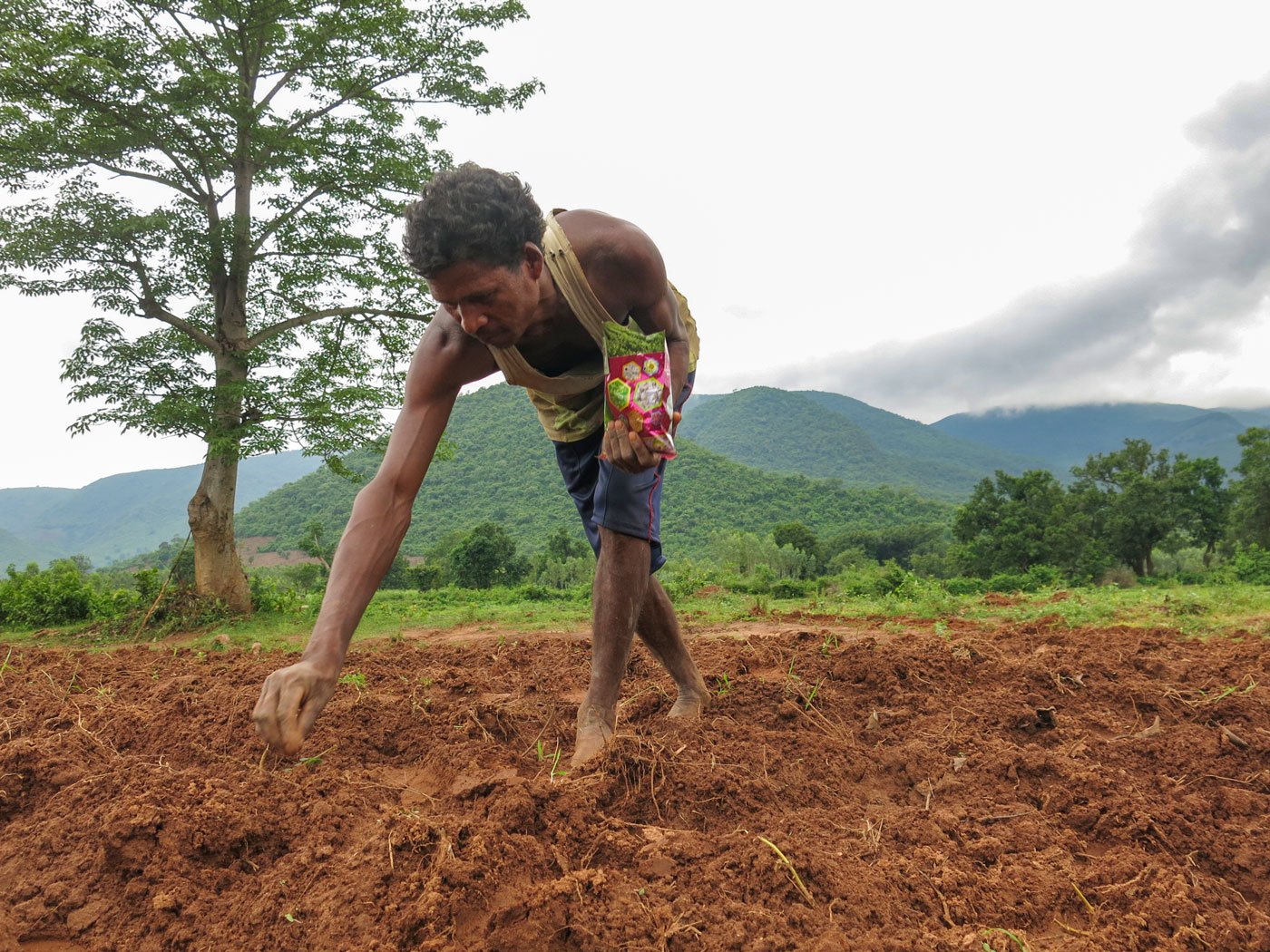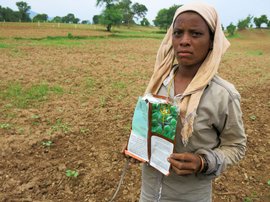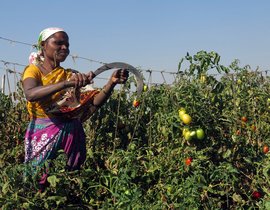“Everybody is doing it. So we are too,” said Rupa Pirikaka, somewhat uncertainly.
‘It’ is genetically modified (GM) Bt cotton seeds, now easily bought at the local market, or even in one’s own village. ‘Everybody’ is countless other farmers like her in the village of and across the rest of south-western Odisha’s Rayagada district.
“They are getting money in their hands,” she says.
Pirikaka is a Kondh Adivasi farmer in her 40s. Every year, for over two decades, she would prepare a hill slope for dongar chaas – literally, ‘mountain farming' (shifting cultivation). Following traditions honed by the region’s farmers over centuries, Pirikaka would sow mixed plots of heirloom seeds which she had saved from family harvests the previous year. These would yield a basket of food crops: millets like mandia and kangu , pulses like pigeon pea and black gram, as well as traditional varieties of long beans, niger seeds and sesame.
This July, for the first time, Pirikaka switched to Bt cotton. That was the time we met her, sowing the dark pink, chemical-doused seeds on a hill slope at her village in Bishamakatak block. The penetration of cotton into the shifting cultivation practices of the Adivasis was striking, making us ask her about this switch.
“Other crops like turmeric also give money,” admits Pirikaka. “But nobody is doing that. Everyone is leaving mandia [millet]… and going after cotton.”
The area under cotton in Rayagada district has risen by over 5,200 per cent in barely 16 years. Official data show just 1,631 acres under cotton in 2002-03. In 2018-19 that was 86,907 acres, according to the district agriculture office.
Rayagada, with close to 1 million people, is a part of the Koraput region, one of the world’s great biodiversity hotspots, and a historical area of rice diversification. A 1959 survey of the Central Rice Research Institute showed the region still had over 1,700 rice varieties at the time. It’s down to around 200 now. Some researchers believe it to be a birthplace of rice cultivation.


In
the Niyamgiri mountains, Adivasi farmers (left) are taking to GM cotton (its pink
seeds are in the box on the right), though many are reluctant to abandon
indigenous food crops such as pigeon pea (seeds in the white bowl). These are sown interspersed with cotton, and agri-chemicals for the
cotton plants seep into the entire farm
The Kondh Adivasis here, largely subsistence farmers, are known for their sophisticated practices of agro-forestry. Even today, many Kondh families across the region’s emerald-green terraced fields and mountainside farms, cultivate a dizzying array of paddy and millet varieties, pulses and vegetables. Surveys by Living Farms, a non-profit in Rayagada, have recently documented 36 millet varieties and 250 forest foods.
Most Adivasi farmers here work on individual or common property farms ranging from 1 to 5 acres in size.
Their seeds are largely nurtured and shared within the community, using almost no synthetic fertilisers or other agri-chemicals (also called agro-chemicals).
Yet, cotton has become the second-most cultivated crop in Rayagada after paddy, overtaking millets – the premier traditional food crops of the region. It covers a fifth of the 428,947 acres under cultivation in this district. Cotton’s swift expansion is reshaping this land and people steeped in agro-ecological knowledge.
Cotton occupies roughly 5 per cent of India’s gross cropped area, but consumes 36 to 50 per cent of the total quantum of insecticides, herbicides and fungicides applied nationally. It is also a crop with the greatest correlation to indebtedness and farmer suicides across India.
The scenario here is reminiscent of Vidarbha between 1998 and 2002 – initial excitement over the new miracle (and then illegal) seeds and dreams of great profits, followed by the effects of their water-guzzling nature, the huge spike in expenses and debt, and various ecological pressures. Vidarbha subsequently ended up as the epicentre of farmer suicides in the country for over a decade. Those farmers were overwhelmingly Bt cotton growers.
*****
The shop we’re standing in is owned by Chandra Kudruka (name changed), a 24-year-old Kondh youth. Returning from Bhubaneswar with a degree in hotel management, he started this store in his village of Rukaguda (name changed) in the Niyamgiri mountains this June. Potatoes, onions, deep-fried snacks, sweets – it seemed like any other village shop.
Except for his hot-selling product – stacked under the counter. A large sack of glossy, multi-coloured packets of cotton seeds, many featuring images of happy farmers and Rs. 2,000 notes.
A bulk of the seed packets in Kudruka’s shop were illegal and unauthorised. Some packets were not labelled at all. Several were not approved for sale in Odisha. Nor was his shop licensed to sell seeds and agri-chemicals.
Also in stock, to be sold with the seeds, were cartons of green and red bottles of the controversial herbicide glyphosate. A World Health Organisation report in 2015 (later contradicted by the WHO under industry pressure) termed glyphosate as ‘probably carcinogenic to humans’. It is banned in states like Punjab and Kerala, restricted in neighbouring Andhra Pradesh, and is currently at the centre of multi-million dollar lawsuits brought by cancer patients in its country of origin, America.


In Kaliponga village, farmers Ramdas and his wife Ratnamani sow BT and
HT cotton just days after dousing their lands with glyphosate, a broad spectrum
herbicide
All this is unknown to farmers in Rayagada. Glyphosate, referred to as ‘ ghaasa maraa ’ – literally ‘grass killer’ – is marketed to them to destroy weedplants on their fields swiftly. But it is a broad spectrum herbicide, which kills all plants other than those which have been genetically modified to resist it. Kudruka also breezily showed us seeds of cotton, which he said will survive the spraying of glyphosate . Such ‘herbicide tolerant’ or ‘HT seeds’ are prohibited in India.
Kudruka had already sold 150 seed packets to farmers in the past fortnight, he said, adding. “I have ordered more. They will be here by tomorrow.”
Business seems to be roaring.
"About 99.9 per cent of the cotton in Rayagada today is Bt cotton – non-Bt seeds are just not available," an officer observing the crop’s cultivation in the district told us off the record. "Officially, Bt cotton is at a standstill in Odisha. It is neither approved, nor banned."
We found no authorisation from the central government agency responsible for allowing release of Bt cotton in the state of Odisha. The Ministry of Agriculture's cotton status report of 2016 in fact shows figures for Bt cotton in Odisha, year upon year, as nil, suggesting that governments would rather not acknowledge its existence. "I don't have information on HT cotton,” state agriculture secretary Dr. Saurabh Garg told us on the phone. “On Bt cotton, whatever is the government of India policy is our policy. We do not have anything separate for Odisha."
That attitude has serious consequences. Trade in unauthorised Bt and illegal HT seeds, as well as in agri-chemicals, is thriving and fast penetrating new areas of Rayagada, as was evident in Kudruka's shop in the Niyamgiri mountains.
Globally, agri-chemicals have destroyed soil microbes, eroded fertility and harmed "countless habitats of plants and animals, both on land and in water,” as Prof. Shahid Naeem recently said. Naeem, who heads the department of ecology, evolution and environmental biology at Columbia University, New York, says, "All these organisms are important, because collectively they make up healthy ecosystems that remove pollutants from our water and air, enrich our soil, nourish our crops and regulate our climate systems."
*****
“It did not come easy, I had to work very hard to get them (Adivasi farmers) to switch to cotton,” said Prasad Chandra Panda.
‘Kappa Panda’ – literally ‘Cotton Panda’ – as he is called by his clients and others, was speaking to us at his seed and chemical inputs shop, Kamakhya Traders, in the tehsil town of Bishamakatak in Rayagada.
Panda opened the shop 25 years ago, all the while holding his job as an extension officer in the district’s agriculture department. He retired after 37 years there, in 2017. As a government officer, he pushed villagers to abandon their “backward agriculture” for cotton, while his shop, licensed in his son Suman Panda’s name, sold them seeds and associated agri-chemicals.

GM cotton seed packets marketed to Adivasi
farmers in Rayagada lack mandatory labelling, are sold at prices above official
caps, can be illegal herbicide-tolerant seeds, and usually don’t list Odisha as
a recommended state for cultivation. Bottom right: P. C. Panda says he does not
sell unauthorised seeds. The recently retired agriculture officer has run a seeds
and inputs shop in Bishamakatak for 25 years
Panda saw no conflict of interest in this, saying, “Government policies introduced cotton as a cash crop for farmers. The crop needed market inputs, so I established a shop.”
Through the two-hour conversation we had in Panda’s shop, farmers kept dropping in to purchase seeds and chemicals, seeking his counsel on what to buy, when to sow, how much to spray and so on. He answered each one with an air of infallible authority. For them, he was the scientific expert, the extension officer, their advisor, all rolled into one. Their ‘choice’ was his command.
The scenes of dependence we witnessed at Panda’s shop played out across the cotton-growing villages we toured. The coming of ‘the market’ has had an impact way beyond the cotton crop.
“As the farm land is entirely allocated for cotton, farmers have to buy all their household necessities from the market,” Debal Deb, scientist and barefoot conservationist, told us. Based in Rayagada since 2011, Deb runs a remarkable in-situ rice conservation project and conducts farmer trainings.
“The traditional knowledge of farm-related as well as non-farm occupations are rapidly disappearing,” he said. In village after village, there is no potter, no carpenter, no weaver. All household goods are bought from the market, and most of these – from the pitcher to the mat – are made of plastics, imported from faraway towns. Bamboos have disappeared from most villages, and with them bamboo crafts. They are now substituted by wood from the forest and expensive concrete. Even for erecting a pole or making a fence, villagers have to cut trees from the forest. The more people depend on the market due to the lure of profit, the more the environment degrades.”
*****
“The shopkeeper said these were good,” Ramdas (he only uses his first name) told us sheepishly, of the three Bt cotton seed packets he had bought on credit from Kudruka’s shop. We had met the Kondh Adivasi farmer at the foothills of the Niyamgiri as he was walking back to his village, Kalipanga, in Bishamakatak block. The shopkeeper’s advice was the sole reason he gave us for choosing those seed packets.
What had he paid for them? “If I had paid just now, Rs. 800 each. But I do not have Rs. 2,400, so the shopkeeper will take Rs. 3,000 from me at harvest time.” But even if he were paying Rs. 800 per packet and not the Rs. 1,000 he eventually will, that would still be costlier than the mandated price of Rs. 730 for the most expensive cotton seed: Bollgard II Bt cotton.
Pirikaka, Ramdas, Suna and other farmers told us that cotton was unlike anything they had planted before: 'Our traditional crops do not require anything to grow ...'
None of the packets Ramdas had purchased displayed a printed price, a manufacturing or expiry date, name or contact details of the company. They featured a huge red ‘X’ overlaid on an image of a bollworm, but were not labelled as Bt seeds. Although the packets did not specify ‘HT’, Ramdas believed the crop “can be sprayed with ghaasa maraa [herbicide]” since the shopkeeper had told him so.
Like every farmer we interviewed over a fortnight in July, Ramdas was unaware that herbicide-tolerant seeds are disallowed in India. He did not know that companies cannot sell unlabelled seeds, or that there are price caps on cotton seeds. Given that none of the writing on seed packets and agri-chemical bottles was in Odia, farmers here would not know what claims manufacturers were making, even if they could read.
Yet, the prospect of money was drawing them to cotton.
“If we grow this, I might make some money I need this year for my son’s fees in a private English-medium school” – that was the hope of Shyamsundar Suna, a Dalit tenant farmer speaking to us in Kerandiguda village of Bishamakatak block. We found him, his Kondh Adivasi wife Kamala, and their two children Elizabeth and Ashish, hard at work sowing cotton seeds. Suna had applied all kinds of agri-chemicals, of which he knew little, to his seeds. “The retailer told me the cotton will come out well,” he explained.
Pirikaka, Ramdas, Suna and other farmers told us that cotton was unlike anything they had planted before. “Our traditional crops do not require anything to grow – no fertiliser, no pesticide,” said Pirikaka. But with cotton, Ramdas said, “each packet demands further expenses of 10,000 rupees. Only if you can spend on these seeds, fertilisers and pesticides, might you get some return at harvest time. If you can’t do this… you will lose all your money. If you can, and things turn out good [with] stable weather – then you might sell it [his harvest] for Rs. 30,000- Rs. 40,000.”
Even as farmers were taking to cotton in the hope of making money,most were hard-pressed to say how much they earned through it.
Come January-February, farmers will have to sell their produce back via the input retailer, who would recoup his costs with exorbitant interest, passing on what remained to them. “I have just ordered 100 packets from the trader in Gunpur on credit,” Chandra Kudruka told us. “I will repay him at the time of harvest, and we will split the interest paid by the farmers.”

Top row: In mid-July, for the first time, Kondh Adivasi farmer Rupa Pirikaka sowed GM cotton seeds from the market in her mountainside plot in Karanjaguda village. Bottom left: Nanda Sarka and her family sowed four packets of Bt cotton on their two acres in Kaliponga village. Bottom right: Shyamsundar Suna and Kamala are tenant farmers in Kerandiguda. They recently started cultivating Bt cotton, and are hoping to make more money to meet their children's education costs
What if the farmers’ crops fail and they cannot pay him back for the packets he has sold them on credit? Isn’t that a big risk?
“What risk?” asked the young man, laughing. “Where will farmers go? Their cotton is sold to the trader through me. If they harvest just 1-2 quintals each, I will recover my dues from that.”
What went unsaid was that the farmers might be left with nothing.
Rayagada will also be left shorn of its precious biodiversity. As Prof. Naeem puts it, globally, eliminating crop diversity means jeopardising food security and reducing the ability to adapt to global warming. He also warned that climate change and biodiversity loss are deeply linked: “a planet that’s less green and less biologically diverse is likely to be hotter and drier."
And as Rayagada’s Adivasi farmers abandon that biodiversity for a monoculture of Bt cotton, Odisha is undergoing a far-reaching shift in ecology and economy, sparking crises at both, the level of the individual household and at that of climate impact. Pirikaka, Kudruka, Ramdas and ‘Cotton Panda’ are among the unlikely cast of characters caught up in this shift.
“Southern Odisha was never a traditional cotton-growing area. Its strength lay in multiple cropping,” said Debal Deb “This commercial cotton monoculture has altered the crop diversity, soil structure, household income stability, farmers' independence, and ultimately, food security.” It sounds like an infallible recipe for agrarian distress.
But these factors, especially those relating to changes in land use, plus what all this implies for water and the rivers, and loss of biodiversity – could also be playing themselves into another long-term, large-scale process. We are witnessing the sowing of the seeds of climate change in this region.
Cover photo: In Kaliponga village, farmer Ramdas sows Bt and
HT cotton a few days after dousing the land with glyphosate, a broad spectrum
herbicide. (Photo: Chitrangada Choudhury)
PARI’s nationwide reporting project on climate change is part of a UNDP-supported initiative to capture that phenomenon through the voices and lived experience of ordinary people.
Want to republish this article? Please write to [email protected] with a cc to [email protected]


